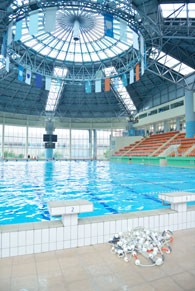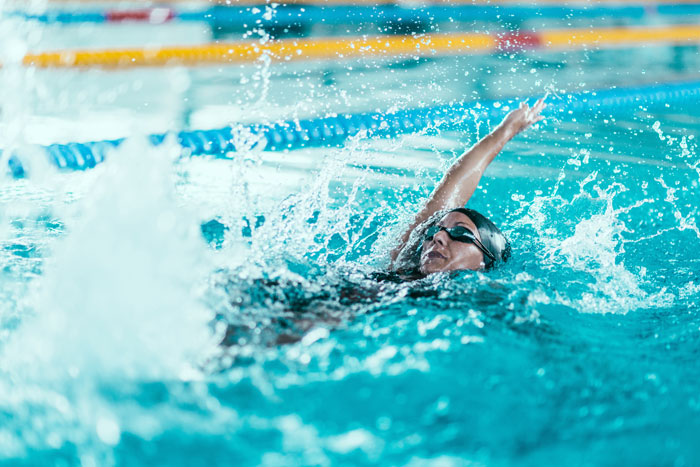By Lynn Walldorf
Indoor pools are hard on light fixtures. The exposure to a warm and humid environment with the addition of chlorine or salt is particularly challenging. Additionally, because natatorium fixtures are difficult to access, maintenance must be kept to a minimum. If any glass from the luminaire were to fall into the pool during maintenance, the entire pool must be drained—an expensive and time-consuming effort.

Safety and accident prevention are the primary driving forces behind natatorium lighting, but because water is a reflector, reducing glare from the fixtures is also critical. Adequate light levels and consistent uniformity are particularly important. Fixtures for this application, at a minimum, need to be damp location rated, offering the highest safeguard against moisture, water treatment and chemical vapor ingress.
Retrofitting energy-wasting metal halide fixtures or other legacy lighting with high-efficiency LED luminaires, along with the proper placement of lights, helps lower maintenance and energy costs.
But more important than just reducing operating costs, the lighting design can eliminate glare and shadows cast onto, and beneath, the water’s surface. Light fixtures suspended from the ceiling and shining directly on the pool surface frequently cast dark shadows from the pool edge that darken the walls of the pool shell. Improperly placed overhead lights can also cast distracting shadows from obstructing ductwork, structural beams and other objects.
It is important to have the right design and luminaires for each application, particularly when safety is an issue. When light reaches the water surface at an angle lower than 50 degrees, it creates reflection and glare, and lifeguards may not see swimmers. Additionally, light fixtures have a dazzling effect on swimmers, which can be uncomfortable. Facilities that have televised events, such as college and university natatoriums, have high lumen requirements for filming and photography purposes. In fact, the NCAA requires that a lighting performance checklist be submitted prior to approval for a championship bid.
Light Level Guidelines
The table refers to the Illuminating Engineering Society of North America’s RP-06-01 for Sports Recreational Area Lighting.
Building and operating an aquatic facility is never easy or inexpensive, but improvements in equipment and innovative technologies continue to offer more sustainable and longer-lasting solutions. When considering an aquatics project, keep in mind both the upfront cost, but also the potential savings gained from using the correct lighting system, such as indirect, durable, IP-rated LED luminaires.
When specifying lighting, the team involved should carefully evaluate the type of swimming pool facility, planned maintenance schedules and budget considerations, and select the lighting that best fits those criteria. Aluminum housings are a common choice, but recently, lighting manufacturers have introduced high-efficiency lighting constructed with stainless-steel housings that resist corrosion. Sealed, stainless-steel natatorium LED lighting is patterned after roadway tunnel lighting and delivers high lumens, long LED life, a tight seal and superior corrosion resistance.
Another lighting technology that has earned its place in natatoriums, particularly since the SARS-CoV-2 pandemic began in 2020, is visible light disinfection. Luminaires containing LEDs in the 405 nanometer range are proven to kill SARS-CoV-2 and Influenza-A, as well as other dangerous pathogens, including staph, such as MRSA, according to a March 2022 article in Nature. When installed in locker rooms and other busy, high-touch areas, these luminaires can prevent the spread of harmful bacteria and viruses while providing ambient light, and—unlike ultraviolet light—are completely safe for room occupants.
Whether building a new facility or retrofitting an existing natatorium, incorporating high-quality, sealed LED lighting can provide safety, comfort, energy savings, reduced maintenance and even safe disinfection—well worth the deep dive to provide such significant benefits. RM



